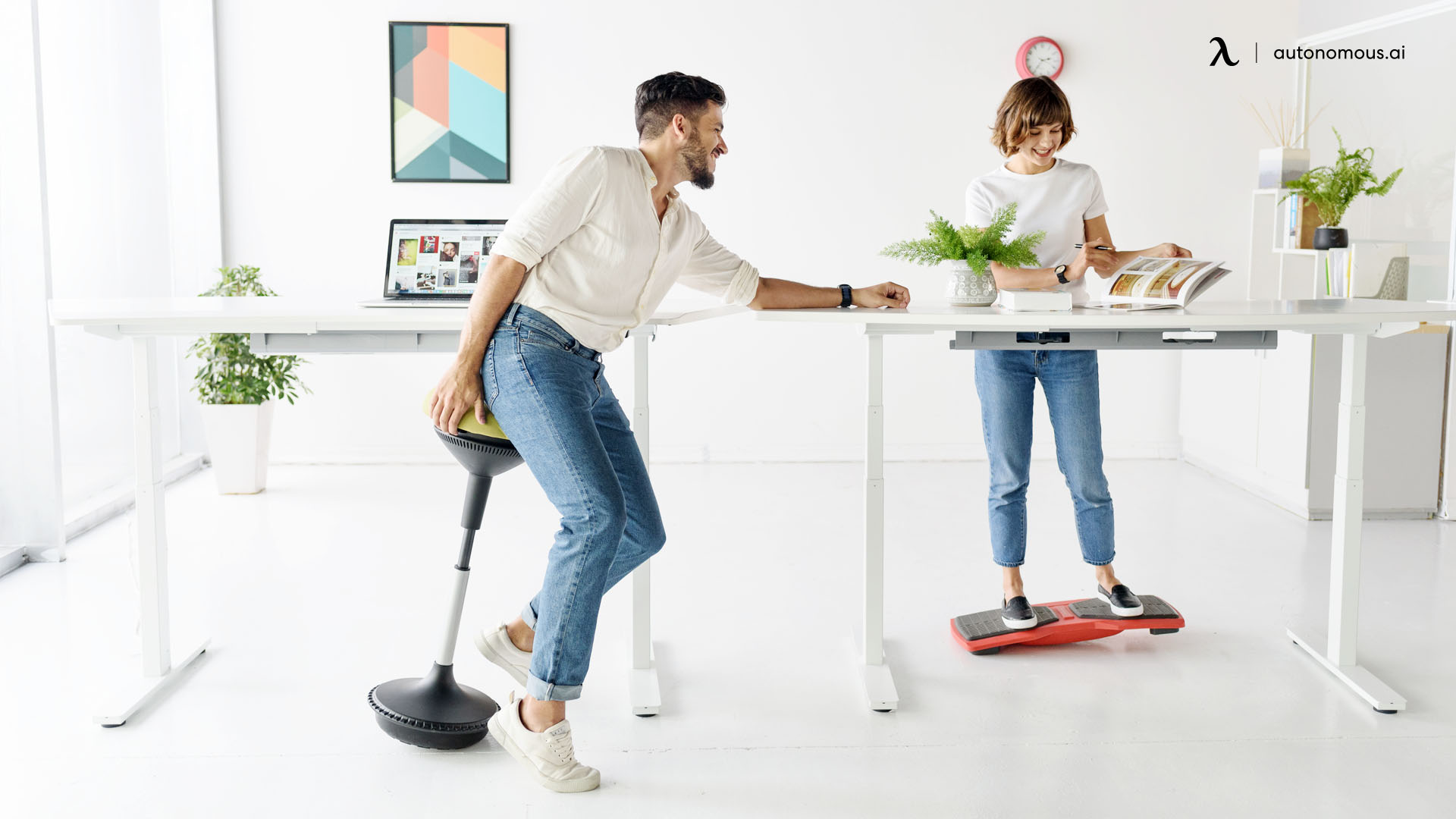
Standing At Work: Beat Your Inactive Working Mood
Table of Contents
The way we work has evolved, with more people embracing standing at work to improve their well-being and productivity. Prolonged sitting has been linked to various health concerns, prompting the rise of ergonomic solutions like standing desks to create healthier work environments. But is standing while working really beneficial? And how can you make the most of it without discomfort?
This guide explores the benefits of standing up at work, how to do it correctly, and the best office furniture to enhance your experience.
Why Standing at Work Matters
Sitting all day can take a toll on your body, leading to poor posture, back pain, and reduced circulation. Standing while working promotes better ergonomics and increased energy levels. Some key benefits include:
- Better Posture & Less Back Pain – Standing naturally encourages a more upright posture, reducing strain on the lower back. For additional support, pairing a standing desk with an ergonomic chair for lower back pain can improve spinal alignment.
- Increased Energy & Productivity – Workers who incorporate standing into their routine often experience higher focus and energy levels, avoiding the sluggishness that comes from prolonged sitting.
- Reduced Risk of Health Issues – Research links excessive sitting to obesity, cardiovascular disease, and diabetes. Alternating between sitting and standing promotes movement, improving overall health.
- Encourages Active Work Habits – Standing makes it easier to stretch, move, and incorporate short walking breaks into the day.
Best Practices for Standing While Working
To maximize the benefits of standing at work, follow these key practices:
1. Find the Right Balance
While standing offers advantages, staying on your feet for too long can cause discomfort. A good rule of thumb is to alternate between sitting and standing every 30-60 minutes. Using an ergonomic stool for a standing desk can help maintain flexibility and comfort.
2. Choose the Right Standing Desk
Investing in a high-quality standing desk is essential for comfort and adjustability. Depending on your workspace needs, you can opt for an L-shaped standing desk for more surface area or a tall standing desk for additional height adjustability.
3. Maintain Proper Posture
Standing with proper alignment is crucial to prevent strain. Keep these tips in mind:
- Stand with your feet shoulder-width apart.
- Keep your shoulders relaxed and your back straight.
- Adjust your desk height so your arms form a 90-degree angle while typing.
For those who prefer extra comfort, an ergonomic chair with a leg rest provides a great way to relax between standing sessions.
4. Use an Ergonomic Workspace Setup
Your workstation setup affects how comfortable and effective your standing routine will be. Consider these upgrades:
- Standing desk legs for DIY customization.
- Standing desk extensions for additional workspace flexibility.
- Standing desk dual monitor setup to optimize screen positioning.
5. Wear Supportive Footwear
Standing on hard surfaces for long hours can lead to foot pain. Wear comfortable, supportive shoes, or use an anti-fatigue mat to reduce strain on your feet.
6. Move While Standing
Standing in one position for too long can cause stiffness. Shift your weight, stretch, or do simple exercises while working to keep your body engaged. If you need to sit, opt for an ergonomic chair to maintain good posture.
When selecting a standing desk, consider these options:
- For DIY Enthusiasts – A DIY standing desk allows for full customization.
- For Maximum Adjustability – The best standing desk combines sturdy design with smooth height adjustments.
Common Mistakes to Avoid While Standing at Work
Even with a well-designed workspace, improper standing habits can lead to discomfort and reduce the benefits of using a standing desk. Here are some key mistakes to watch out for:
1. Standing Too Long Without Breaks
Balance is key when incorporating standing into your work routine. While standing up at work offers great health benefits, staying on your feet for prolonged periods without rest can lead to fatigue and discomfort. The best approach is to alternate between sitting and standing, adjusting based on how your body feels. Using an ergonomic office setup, such as the right office desk design, can help create a comfortable balance.
2. Improper Desk Height
The height of your standing desk is crucial for maintaining good posture and preventing strain. A desk that is too high or too low can cause discomfort in your neck, shoulders, and wrists. The ideal height allows your elbows to form a 90-degree angle while typing. If you’re unsure how to position your desk correctly, check out this guide on how to use a standing desk to ensure an ergonomic setup.
3. Poor Posture
Just as slouching is bad while sitting, leaning forward or standing incorrectly can negate the benefits of a standing desk. To maintain proper posture:
- Keep your feet flat on the floor, shoulder-width apart.
- Engage your core and avoid locking your knees.
- Keep your screen at eye level to prevent neck strain.
Proper ergonomics and maintaining awareness of your posture will help you work comfortably and prevent musculoskeletal issues over time.
4. Wearing Unsupportive Shoes
If you're standing for long hours, the type of footwear you wear matters. Uncomfortable shoes can cause foot pain and fatigue, leading to poor posture. Opt for supportive, cushioned shoes or use an anti-fatigue mat to reduce strain. Additionally, taking breaks to stretch or move around can help prevent stiffness.
FAQs
How long should I stand at work each day?
Experts recommend standing for 30-45 minutes per hour, alternating with sitting to avoid strain.
Can standing at work improve productivity?
Yes! Studies show that standing can boost energy levels and focus, leading to increased workplace productivity.
Should I use a standing desk mat?
Yes, an anti-fatigue mat can help reduce foot strain and enhance comfort while standing.
What’s the best seating option for a standing desk?
An ergonomic stool allows for easy transitions between sitting and standing.
Final Thoughts
Standing while working has numerous health benefits, from improved posture to increased productivity. By incorporating a high-quality standing desk and following best practices, you can create a healthier and more ergonomic work environment.
Finding the right balance between sitting and standing up at work is key. Whether you opt for standing desk legs or reclining ergonomic chairs, investing in the right office setup will make a noticeable difference in your daily routine.
Stay connected with us!
Subscribe to our weekly updates to stay in the loop about our latest innovations and community news!



/https://storage.googleapis.com/s3-autonomous-upgrade-3/production/ecm/230914/bulk-order-sep-2023-720x1200-CTA-min.jpg)

/https://storage.googleapis.com/s3-autonomous-upgrade-3/production/ecm/230824/Amanda-8035f52a-7230-4c31-9bda-626fd7c392bf.jpg)